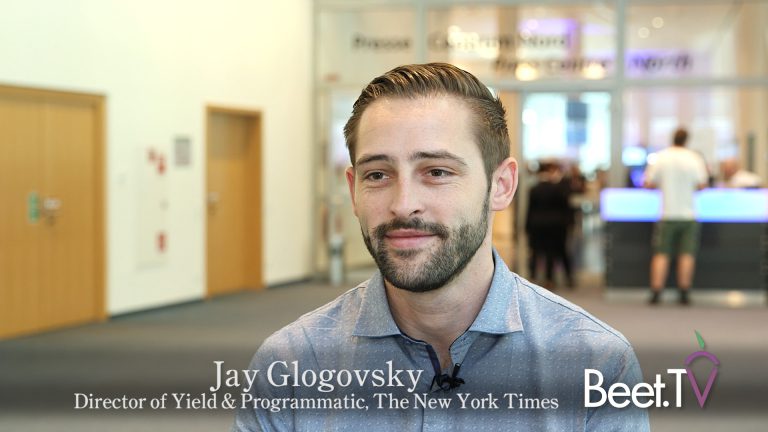
COLOGNE — When Europe’s new GDPR consumer data law came in to effect on May 24, introducing new limits on how companies could process and target using consumers’ data, it caused a big drop-off in the amount of advertising being bought programmatically.
Sharp eyes noticed that programmatic ad demand volume dropped by up to 40%, and that The New York Times was no longer carrying programmatically-traded ads in Europe.
Whilst, since then, things have picked back up, the Times has not restarted programmatic trading in Europe, the man responsible confirms to Beet.TV in this video interview.
“The Times never wants to be in a situation where we are abusing privacy of our users, especially the ones that are paying such a premium price to be a subscriber,” says New York Times director of yield and programmatic Jay Glogovsky.
“So we have taken a very conservative approach to ensure that we are a very trusted publisher. And we have really rolled back our programmatic efforts within the EEA [European Economic Area] region.
“We are going to be slowly and incrementally rolling out programmatic again in the EU. But that is still, right now, not on the table. It’s something that we’re experimenting with in the future.”
It’s not that Europe isn’t significant to the Times. The publisher is on a mission to be a leading global news source, and previously absorbed its sister title, International Herald Tribune, which had catered to international audiences, in to its own brand.
But, by continuing – at least – to publish in Europe, the Times is at least keeping the lights on, whilst publishers like Hearst have taken the decision to entirely block themselves from access by users in Europe.
Either way, for Glogovsky, programmatic is a means to an end. “Success around programmatic means very high quality ads surrounding our excellent journalism, success to us is less of our users complaining about ads,” he says.
“That’s a change for a lot of publishers, because they turn on programmatic to let the rain come in on revenue.”
The New York Times has also cut the number of demand-side ad-tech platform partners to which it is connected, effectively limited who can buy its ads – all part of what Glogovsky hopes is a flight toward quality ad creative.
“What we realized was it’s more valuable to actually be able to manage the number of partners that we have then just throwing another partner onto our site,” he explains.
But the newspaper isn’t turning away from ad-tech. The Times has also introduced technology to aid ad placement against the best content, and has even build a “perspective targeting” tool that uses predictive modelling to target ads to users based off their anticipated emotional response.
This video is part of a series produced at DMEXCO 2018 in Cologne titled: “Finding Success in a Time of Transformation.” It is is presented by PubMatic. For segments from the series, please visit this page.